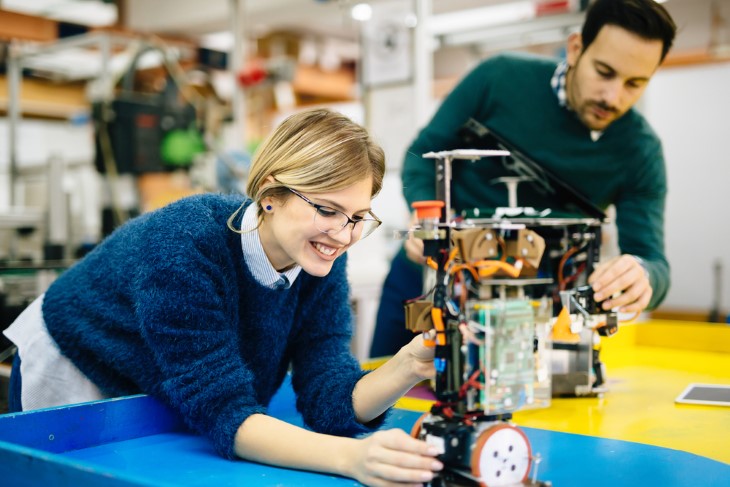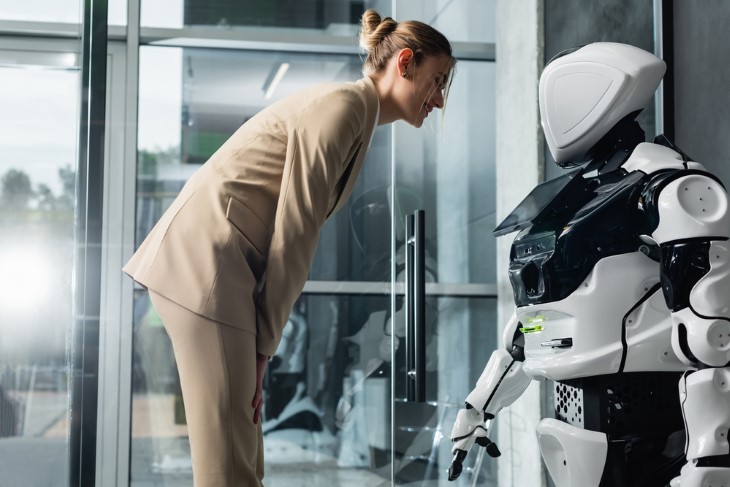
As we bid farewell to 2023, a year marked by significant shifts in the robotics domain, it's crucial to cast our gaze forward. The forthcoming year, 2024, beckons with the promise of further advancements and widespread adoption of robotics technologies. Let’s delve into five pivotal trends that are poised to redefine the landscape of robotics this year.
1. The Dawn of More Intuitive and Social Robots Through Generative AI
The influence of generative AI on robotics, a major driving force in 2023, is set to deepen in 2024. Integrating advanced language models, similar to ChatGPT, into robotics is not just an emerging trend but a revolutionary leap. As Brandon Minor, the co-founder and CEO of Tangram Vision, insightfully points out, this fusion of natural language processing and perception hardware is not just an engineering marvel but a sprinkle of 'magic' in tech demonstrations. This integration is anticipated to foster a new breed of robots that are quicker learners and adept in complex tasks, further enhancing their commercial viability. Boston Dynamics has already set a precedent by transforming its Spot quadruped into a tour guide using ChatGPT, hinting at more such innovative applications in the year ahead. Amir Bousani, co-founder and CEO of RGo Robotics, underscores a shift from hardware-centric to software-focused development in the robotics industry, recognizing generative AI's potential in enriching mobile robots’ interaction with their surroundings.

2. Robots Venturing Beyond Warehouses
As we delve into the year 2024, the landscape of robotics is undergoing a remarkable transformation. Robots, once predominantly confined to the controlled environments of manufacturing plants and warehouses, are poised to step into the broader world. This shift is largely driven by advancements in generative AI, enabling robots to take on roles that are more interactive and dynamic, directly impacting the public sphere.
Adam Rodnitzky, co-founder and COO of Tangram Vision, forecasts a significant surge in the presence of robots across various public venues. We can expect to see robots performing a myriad of tasks in settings such as restaurants, hotels, and hospitals. In restaurants, robots could be seen assisting with serving food, managing reservations, or even providing interactive experiences for guests. Hotels might employ robots for concierge services, handling luggage, or ensuring efficient room service. Hospitals could benefit from robots in numerous ways, from delivering supplies and medications to aiding in patient care and administrative tasks.
This burgeoning expansion into public-facing roles can be partly attributed to the growth and maturation of startups specializing in robotic technology. These companies have been developing and refining their robotic solutions, and are now at a stage where they can deploy reliable and efficient robotic fleets suited for public interaction.
3. The Expansion of Mobile Robot Applications
The domain of autonomous mobile robots (AMRs), once a burgeoning field, has now burgeoned into a multi-billion-dollar industry. Rasmus Smet Jenson, VP of Marketing and Strategy at Mobile Industrial Robots (MiR), observes that industries are now integrating large fleets of robots into their core operations, a significant leap from the initial phase of experimentation. While warehouses have been the primary domain for these robots, 2024 is likely to see them stepping into more dynamic environments like airports and outdoor settings. Tom Ryden, Executive Director of MassRobotics, anticipates a surge in the deployment of mobile robots, facilitated by their enhanced data processing capabilities and proven return on investment. MiR expects the emergence of novel solutions like mobile cobots and AMR pallet jacks, in response to growing market demands.

4. Humanoids Continue to Captivate but Widespread Deployment Remains Elusive
The allure of humanoid robots continues unabated in 2024. While companies are zealously unveiling new models, the widespread deployment of these human-like robots in the workforce is still a few years away. Bousani from RGo Robotics emphasizes the need for educating customers and end-users about the distinct advantages of robotics. Despite the considerable investment in humanoid robots like Agility Robotics' Digit, their mainstream application is not on the immediate horizon.

5. Enhanced Human-Robot Collaboration and Co-Existence
As we venture into 2024, the robotics industry is poised to witness a significant trend towards fostering greater collaboration and co-existence between humans and robots. This trend is not just about technological advancements but also a shift in the workplace culture and societal acceptance of robots as collaborative partners.
The integration of robots into the workforce has traditionally been seen in roles that are repetitive, hazardous, or require precision beyond human capability. However, the emerging trend is to use robots to complement and augment human skills, rather than merely replace human labor. This means designing robots that can work alongside humans, assisting them in tasks, enhancing productivity, and ensuring safety. For example, in a manufacturing setting, cobots (collaborative robots) could work side by side with human workers, handling heavy lifting or precision tasks, while humans focus on more complex, strategic work.
The advancements in AI, machine learning, and sensor technology are crucial in making this collaboration more intuitive and safe. Robots are becoming better equipped to understand and predict human actions, adjust their movements accordingly, and respond to verbal and non-verbal cues. This level of sophistication enables a more natural interaction between humans and robots, making the collaboration more effective and less intrusive.

With the increased presence of robots in the workforce, there will be a growing need for education and training programs that focus on human-robot interaction. Workers will need to be trained not only on how to operate these machines but also on how to effectively collaborate with them. This includes understanding the capabilities and limitations of robots and learning new skills that complement robotic technology.
As robots become more embedded in our daily lives and workplaces, ethical and social considerations will come to the forefront. This includes addressing concerns about job displacement, privacy, and the ethical treatment of robots. It’s crucial to develop guidelines and policies that ensure the responsible deployment and use of robotics technology in a way that benefits society as a whole.
Final Note
As we venture into 2024, these trends not only signify technological advancements but also indicate a shift in how we perceive and integrate robotics into our daily lives. The journey ahead for the robotics industry appears both exciting and transformative.